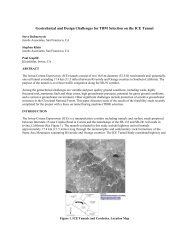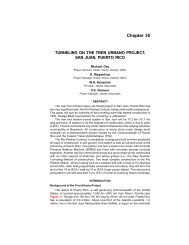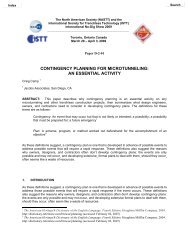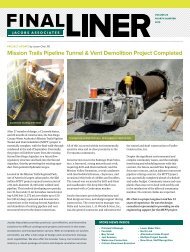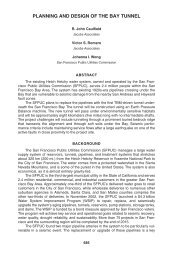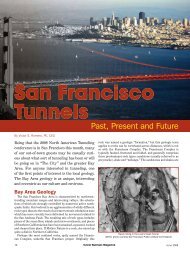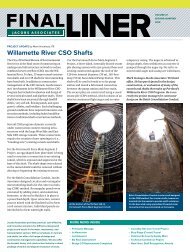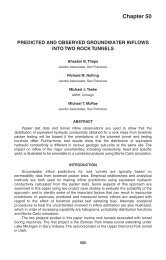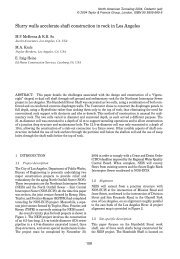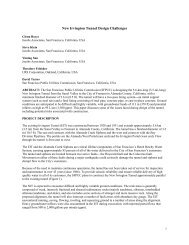Riverside Badlands Tunnel, Inland Feeder Project - Jacobs Associates
Riverside Badlands Tunnel, Inland Feeder Project - Jacobs Associates
Riverside Badlands Tunnel, Inland Feeder Project - Jacobs Associates
You also want an ePaper? Increase the reach of your titles
YUMPU automatically turns print PDFs into web optimized ePapers that Google loves.
996 2003 RETC PROCEEDINGS<br />
Figure 2.<br />
Geologic profile along tunnel<br />
proportions: 10 percent soft ground (alluvium); 66 percent weak sedimentary rock (San<br />
Timoteo Formation); and 24 percent strong but variably fractured and sheared hard rock<br />
(metamorphic rocks). Several fault zones were also identified that crossed the tunnel<br />
alignment. The alluvium typically consists of dense to very dense silty and gravelly sands<br />
with local silt and clay layers. The San Timoteo Formation is a weak sedimentary<br />
formation that varies in strength from about 0.7 to 13.8 MPa (100 to 2,000 psi), except<br />
where the formation is uncemented and its strength is negligible. The metamorphic rocks<br />
are stronger, exhibiting strength values generally in the range of about 35 to 175 MPa<br />
(5,000 to 25,000 psi). Except for limited areas near the portals, approximately 90% of the<br />
tunnel is below the groundwater level with levels that range up to 100 m (330 ft) above<br />
the tunnel invert. Figure 2 is a geologic profile that shows the distribution of the geologic<br />
units along the tunnel. Several alternative tunnel profiles were evaluated during design<br />
that offered more uniform geology, however, these profiles were determined to be less<br />
desirable due to cost, constructability, and operational disadvantages.<br />
The tunnel alignment was divided into ten reaches that were established based on<br />
the geologic units expected in the tunnel. These reaches are summarized in Table 1.<br />
Anticipated ground conditions included: raveling, running, and flowing ground in the<br />
alluvium; raveling, squeezing, and flowing ground in the San Timoteo Formation; and<br />
moderately jointed, blocky and seamy, and crushed rock in the metamorphic rocks. A<br />
more detailed discussion of the anticipated ground conditions is provided in Redd et al.<br />
(1997) and in the Geotechnical Design Summary Report [GDSR] (DMJM/WCC, 1997).<br />
<strong>Tunnel</strong> Design Approach<br />
Some of the important considerations that were addressed during design included:<br />
Need for positive groundwater control measures to prevent flowing ground in<br />
the alluvium.<br />
Potential for overstressed conditions in the weak San Timoteo Formation.<br />
Strong, variably fractured and sheared metamorphic rocks<br />
Highly fractured, crushed metamorphic rock and fault gouge in the Banning<br />
Fault zone (and other faults) under hydrostatic heads up to 100 m (330 ft).<br />
Uncemented zones in the San Timoteo Formation which could flow.<br />
Initial ground support requirements in the expected raveling, running, flowing,<br />
highly fractured, and crushed ground with low stand up time.<br />
Design of a watertight final lining for the tunnel to withstand the internal water<br />
pressures and external ground water pressures.



